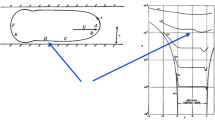Abstract
This work investigates the governing mechanisms of minimum film thickness in elastohydrodynamic lubricated contacts. Up until now, it was thought to be governed by lubricant rheology in the low-pressure contact inlet. Through numerical simulations of EHL line and circular contacts, lubricated with fluids having the same low-pressure viscosity, but a very different response at high-pressure, minimum film thickness is shown to be governed by lubricant inlet rheology only in the theoretical line contact configuration. In real contacts however, it is not only governed by inlet rheology, but also by the high-pressure viscosity response of the lubricant. It is observed that the greater the viscosity at high pressure, the lower the minimum film thickness would be, as a result of reduced lateral flow out of the contact. Conservation of mass requires then that a higher minimum film thickness would be attained along the central line of the contact, in the entrainment direction. These findings corroborate well with experimental observations.









Similar content being viewed by others
Data availability
The authors declare that all data supporting the findings of this study are available within the article.
References
Jacobson, B., Kalker, J.J.: Rolling contact phenomena. CISM International Centre for Mechanical Sciences, Number 411, (Eds.). Springer, New York, p. 371 (2000)
Goswami, D.Y.: The CRC Handbook of Mechanical Engineering, pp. 3–164. CRC Press, Boca Raton (2004)
Jacobson, B.O.: Rheology and Elastohydrodynamic Lubrication, vol. 19, p. 276. Elsevier, Amsterdam (1991)
Hamrock, B.J., Schmid, S.R., Jacobson, B.O.: Fundamentals of Fluid Film Lubrication, vol. 169, p. 298. CRC Press, Boca Raton (2004)
Williams, J.: Engineering Tribology, vol. 10, p. 340. Cambridge University Press, Cambridge (2005)
Holmberg, K., Matthews, A.: Coatings tribology: properties, mechanisms, techniques and applications in surface engineering. In: Tribology and Interface Engineering Series, No. 56, 2009, Elsevier, Amsterdam, p. 67.
Chaomleffel, J.P., Dalmaz, G., Vergne, P.: Experimental results and analytical predictions of EHL film thickness. Tribol. Int. 40, 1543–1552 (2007)
Habchi, W: Finite element modeling of elastohydrodynamic lubrication problems. Wiley, Chichester, UK, ISBN: 978-1-119-22512-6 (2018)
Wheeler, J.D., Vergne, P., Fillot, N., Philippon, D.: On the relevance of analytical film thickness EHD equations for isothermal point contacts: qualitative or quantitative predictions? Friction 4, 369–379 (2016)
Aderin, M.G.J.H.A., Johnston, G.J., Spikes, H.A., Caporiccio, G.: The elastohydrodynamic properties of some advanced non hydrocarbon-based lubricants. Lubr. Eng. 48(8), 633–638 (1992)
Glovnea, R.P., Spikes, H.A.: Elastohydrodynamic film collapse during rapid deceleration: Part II-Theoretical analysis and comparison of theory and experiment. J. Tribol. 123(2), 262–267 (2001)
Habchi, W., Bair, S.: Quantifying the inlet pressure and shear stress of elastohydrodynamic lubrication. Tribol. Int. 182(4), 108351 (2023)
Bair, S.: Pressure-viscosity behavior of lubricants to 14 GPa and its relation to EHD traction. Tribol. Trans. 43(1), 91–99 (2000)
Habchi, W., Vergne, P.: A quantitative determination of minimum film thickness in elastohydrodynamic circular contacts. Tribol. Lett. 69(4), 142 (2021)
Sperka, P., Krupka, I., Hartl, M.: Analytical formula for the ratio of central to minimum film thickness in a circular EHL contact. Lubricants 6, 80 (2018)
Bair, S., Khonsari, M.: An EHD inlet zone analysis incorporating the second Newtonian. J. Tribol. 118(2), 341–343 (1996)
Bair, S., Vergne, P., Marchetti, M.: The effect of shear-thinning on film thickness for space lubricants. Tribol. Trans. 45(3), 330–333 (2002)
Bair, S., Mary, C., Bouscharain, N., Vergne, P.: An improved Yasutomi correlation for viscosity at high pressure. Proc. Inst. Mech. Eng. Part J 227(8), 1056–1060 (2013)
Cioc, C., Cioc, S., Moraru, L., Kahraman, A., Keith, T.G., Jr.: A deterministic elastohydrodynamic lubrication model of high-speed rotorcraft transmission components. Tribol. Trans. 45(4), 556–562 (2002)
Bair, S., Krupka, I., Sperka, P., Hartl, M.: Quantitative elastohydrodynamic film thickness of mechanically degraded oil. Tribol. Int. 64, 33–38 (2013)
Habchi, W., Bair, S., Qureshi, F., Covitch, M.: A film thickness correction formula for double-newtonian shear-thinning in rolling EHL circular contacts. Tribol. Lett. 50(1), 59–66 (2013)
Krupka, I., Bair, S., Kumar, P., Khonsari, M.M., Hartl, M.: An experimental validation of the recently discovered scale effect in generalized Newtonian EHL. Tribol. Lett. 33(2), 127–135 (2009)
Krupka, I., Kumar, P., Bair, S., Khonsari, M.M., Hartl, M.: The effect of load (pressure) for quantitative EHL film thickness. Tribol. Lett. 37(3), 613–622 (2010)
Wu, S.R.: A penalty formulation and numerical approximation of the Reynolds-Hertz problem of elastohydrodynamic lubrication. Int. J. Eng. Sci. 24(6), 1001–1013 (1986)
Habchi, W., Eyheramendy, D., Vergne, P., Morales-Espejel, G.E.: Stabilized fully-coupled finite elements for elastohydrodynamic lubrication problems. Adv. Eng. Softw. 46, 4–18 (2012)
Habchi, W., Issa, J.S.: An exact and general model order reduction technique for the finite element solution of elastohydrodynamic lubrication problems. ASME J. Tribol. 139(5), 51501 (2017)
Deuflhard, P.: Newton Methods for Nonlinear Problems, Affine Invariance and Adaptive Algorithms. Springer, Germany (2004)
Bair, S.S.: High Pressure Rheology for Quantitative Elastohydrodynamics, 2nd edn. Elsevier, Amsterdam (2019). (ISBN: 9780444641564)
Houpert, L.: New results of traction force calculations in elastohydrodynamic contacts. J. Tribol. 107(2), 241–248 (1985)
Acknowledgements
Film thickness measurements were carried out with the support of the Czech Science Foundation Project No. 21-28352S.
Author information
Authors and Affiliations
Contributions
WH wrote the main manuscript and carried out the numerical simulations. PS carried out the experiments. SB worked out the rheological modeling. All authors reviewed the manuscript.
Corresponding author
Ethics declarations
Conflict of interest
The authors declare that they have no known competing financial interests or personal relationships that could have appeared to influence the work reported in this paper.
Additional information
Publisher's Note
Springer Nature remains neutral with regard to jurisdictional claims in published maps and institutional affiliations.
Rights and permissions
Springer Nature or its licensor (e.g. a society or other partner) holds exclusive rights to this article under a publishing agreement with the author(s) or other rightsholder(s); author self-archiving of the accepted manuscript version of this article is solely governed by the terms of such publishing agreement and applicable law.
About this article
Cite this article
Habchi, W., Sperka, P. & Bair, S. Is Elastohydrodynamic Minimum Film Thickness Truly Governed by Inlet Rheology?. Tribol Lett 71, 96 (2023). https://doi.org/10.1007/s11249-023-01771-y
Received:
Accepted:
Published:
DOI: https://doi.org/10.1007/s11249-023-01771-y



